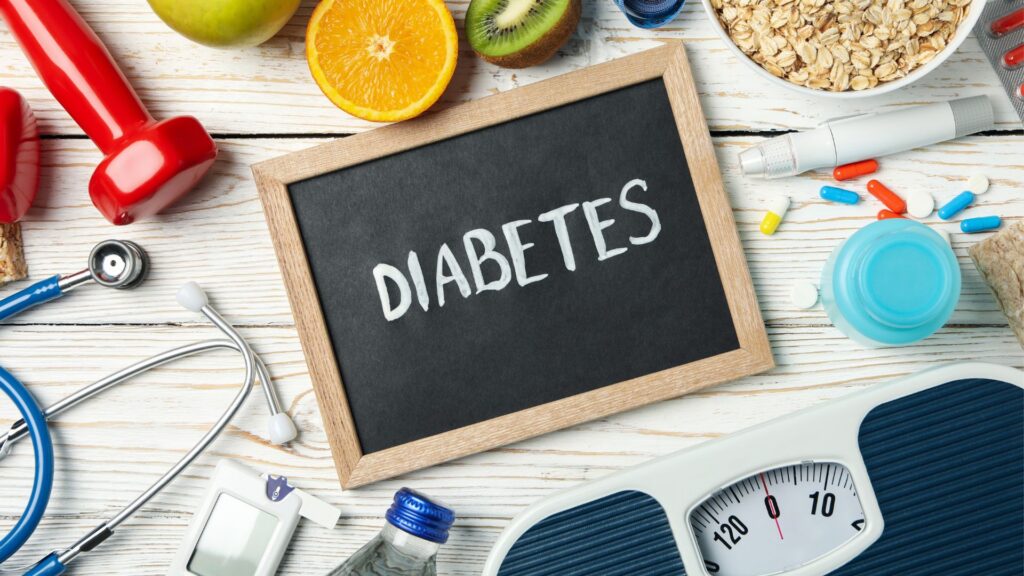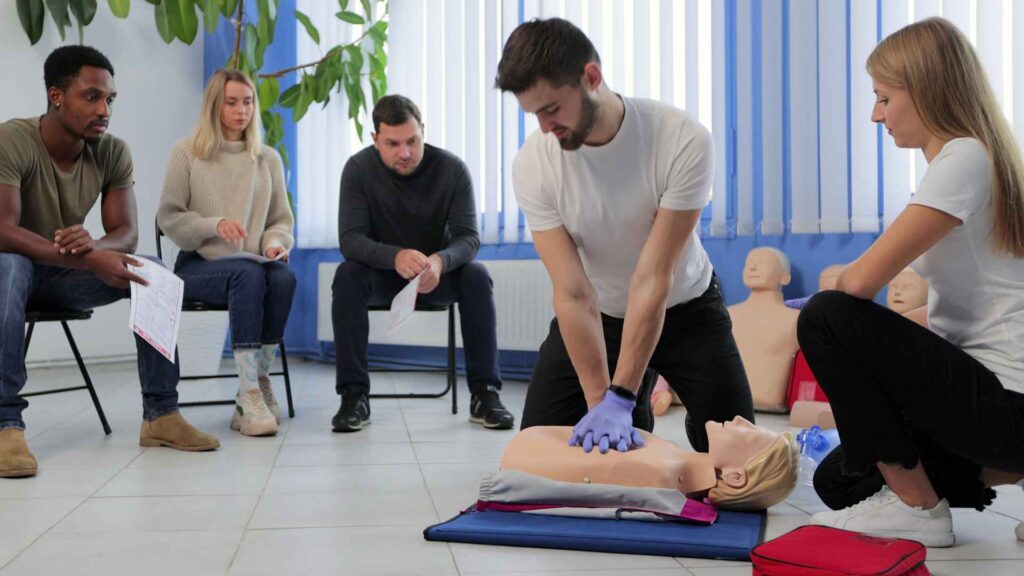Diabetes is a chronic condition characterized by the body’s inability to process glucose (sugar) in the bloodstream. An organ called the pancreas secretes insulin, a hormone that causes glucose to move from the bloodstream into the cells, where it is used for energy.
Insulin helps the body control sugar levels in the blood. Individuals who have diabetes, have high levels of sugars in their blood. This happens because their body does not make enough insulin or their body cannot use insulin correctly. A person with diabetes can control their blood glucose levels the condition with insulin injections or oral medication.
It is important for people with diabetes to time their meals and snacks in relation to their exercise and medication schedules. They may need to check their blood sugar level more frequently if their daily routine changes due to factors like illness or vacation, as this can cause the blood sugar level to fluctuate more than usual.
When a person’s food intake, exercise, and medication are not properly balanced, they may experience a diabetic emergency. This occurs when the level of glucose in their blood fluctuates outside the normal range, causing either hyperglycemia (high blood sugar) or hypoglycemia (low blood sugar).
Types of Diabetes
The four main types of diabetes consist of
- Type 1
- Type 2
- Gestational Diabetes (diabetes while pregnant)
- Prediabetes

Type 1 Diabetes
Type 1 diabetes results from an autoimmune reaction where the body mistakenly attacks its own insulin-producing cells. This reaction stops your body from making insulin. Approximately 5-10% of the people who have diabetes have type 1. Symptoms of type 1 diabetes often develop quickly.
Type 1 diabetes is often diagnosed in children, teenagers, and young adults, and requires daily insulin administration for survival.
Type 2 Diabetes
Type 2 diabetes is characterized by the body’s inability to use insulin effectively, leading to difficulty in regulating blood sugar levels within normal range. About 90-95% of people with diabetes have type 2. It develops over many years and is usually diagnosed in adults but more and more in children, teens, and young adults. Type 2 diabetes can be prevented or delayed with healthy lifestyle changes, such as losing weight, eating healthy & food being active.
Inquire about First Aid Training
The Good Samaritan Act is covered in all of our First Aid & CPR courses. Learn more about it and register today! Contact our customer service team.
Gestational Diabetes
Gestational diabetes occurs in women during pregnancy who have not previously been diagnosed with diabetes. When a woman has gestational diabetes, there is an increased likelihood that her baby may experience health issues. Gestational diabetes usually goes away after the baby is born. As a result of gestational diabetes, there is a risk of developing type 2 diabetes in the future. Moreover, children of mothers with gestational diabetes are more prone to childhood or adolescent obesity and have a greater chance of developing type 2 diabetes later in life.

Prediabetes
Prediabetes is a condition where blood glucose levels are higher than normal, but not yet high enough to be diagnosed as type 2 diabetes. This condition, also known as Borderline Diabetes, is a metabolic disorder that is closely linked with obesity and is rapidly becoming a major global health concern. If undiagnosed or untreated, prediabetes can progress into type 2 diabetes, a condition that is manageable but not entirely reversible.
A critical factor in the development of prediabetes is insulin resistance, where the body needs to produce more insulin to manage blood glucose levels effectively. Over time, the pancreas may struggle to produce enough insulin, and in some cases, too much insulin can be secreted into the bloodstream. This leads to fluctuating blood glucose levels, increasing the risk of developing severe hypoglycemia or insulin shock, where blood sugar drops dangerously low, causing symptoms such as dizziness, confusion, and even loss of consciousness.
Recognizing the early warning signs of prediabetes is crucial for preventing its progression. Some of these signs include increased thirst, frequent urination, fatigue, and blurred vision. The American Diabetes Association emphasizes the importance of routine screening for those at higher risk, including individuals who are overweight, sedentary, or have a family history of diabetes.
Lifestyle changes, such as improving diet, increasing physical activity, and managing weight, can help regulate blood glucose levels and reduce the risk of advancing to type 2 diabetes. Additionally, it’s important to be cautious when drinking alcohol, as alcohol can interfere with blood sugar control and may lead to both high or low blood sugar, particularly for individuals with insulin resistance.
What causes Prediabetes ?
Insulin serves as a key to allow glucose into the cells where it can be utilized as a source of energy. If you have prediabetes, the cells in your body do not respond normally to insulin. To compensate for this lack of response, your pancreas increases its insulin production. However, over time, the pancreas becomes unable to maintain this level of output, resulting in elevated blood sugar levels and creating conditions conducive to the development of prediabetes, which can ultimately lead to type 2 diabetes.
Signs and Symptoms of Prediabetes
Prediabetes can persist for years without exhibiting any distinct symptoms, making it difficult to identify until more severe health issues, such diabetes types 2 emerge.
If you have any of the risk factors for prediabetes, it is crucial to discuss getting your blood sugar tested with your doctor. These risk factors include:
Being overweight
Being 45 years or older
Having a parent, brother, or sister with type 2 diabetes
Being physically active less than 3 times a week
Having polycystic ovary syndrome
Ever having gestational diabetes or giving birth to a baby who weighed more than 9 pounds.
|
Diabetic Coma
A diabetic coma is a severe condition that can result in loss of consciousness and is considered a medical emergency. Individuals with uncontrolled diabetes are at higher risk for developing a diabetic coma when their blood sugar levels become dangerously high (hyperglycemia) or dangerously low (hypoglycemia). Diabetes complications such as diabetic ketoacidosis (DKA) or severe hypoglycemia can trigger this life-threatening event. It’s important to recognize the warning signs of a diabetic coma—such as confusion, excessive thirst, or rapid breathing—and seek immediate medical attention to prevent further diabetes complications. In some cases, insulin therapy may be required to stabilize blood sugar levels and prevent the condition from escalating. Prompt intervention is essential to avoid long-term damage and improve the chances of recovery.
Hyperglycemia
Hyperglycemia is when there is too much sugar in the blood due to a lack of insulin. Eating too much, not taking enough medication, decreased physical activity, or experiencing physical or emotional stress can cause hyperglycemia. This means that the sugar levels in the blood become too high.
Hyperglycemia develops gradually, which means it is unlikely to require immediate medical attention as a first aid emergency.
Hypoglycemia
Hypoglycemia happens when the amount of insulin in the blood is too high compared to the amount of sugar present. This can cause the little sugar present to be used up quickly. Hypoglycemia can occur if a person skips a meal or snack, engages in more physical activity than usual, vomits, or takes too much medication.
Signs and Symptoms of Hyperglycemia & Hypoglycemia
Hyperglycemia (High Blood Sugar)
| Hypoglycemia (Low Blood Sugar)
|
Causes of Diabetes Emergency
An emergency diabetic condition is a serious complication that can arise when two or more of the following factors become imbalanced: insulin production, food intake, medication, and exercise. These factors play a crucial role in regulating blood sugar levels in individuals with diabetes.
Signs and Symptoms of Diabetic Emergency
The following are signs and early symptoms of a diabetic emergency:
|
Register for CPR and First Aid Training
Helping someone who is experiencing a Diabetic Emergency
It is advisable to call 911 and place the individual under a recovery position:
If the person is unable to follow simple commands.
If the person is unable to swallow safely and is unresponsive
If the person does not respond after ten minutes of given sugar or insulin
If the person are unable to give the person sugar
If the person is not fully awake
If person has a seizure
If the individual can comply with basic instructions, respond to inquiries, and swallow without difficulty, provide them with 15 to 20 grams of sugar. To determine the appropriate amount to administer, check the nutrition information on the packaged products. The following is a list of recommended sugar sources, arranged in order of preference:
Oral glucose tablets
Chewable candy
Fruit juice
Fruit strips
Milk
Other sugar types, such as non-diet soda or a spoonful of granulated sugar dissolved in water
You should monitor the person’s condition for approximately 10 minutes.
If the individual’s condition does not improve or worsens after 10 minutes, call 911 and administer more sugar.
If the person’s condition improves, advise them to have a complete meal and their doctor as soon as possible.
At Coast2Coast First Aid, we understand the importance of being prepared to assist individuals experiencing diabetic emergencies. That’s why we offer Emergency First Aid & CPR/AED and Standard First Aid courses that provide comprehensive training on diabetes and how to effectively respond in various scenarios.
Our courses are designed to equip you with practical knowledge and skills, including administering insulin or glucose tablets, to help you confidently assist those in need.
By enrolling in our courses, you will have access to experienced instructors who will guide you through the training process and provide you with valuable insights and techniques. We believe that learning should be engaging and enjoyable, which is why we have developed interactive training sessions that are both informative and enjoyable.
Don’t wait any longer to acquire the skills needed to respond in emergency situations. Begin your training today by registering for our Emergency First Aid & CPR/AED and Standard First Aid courses.



















